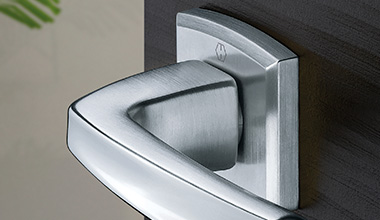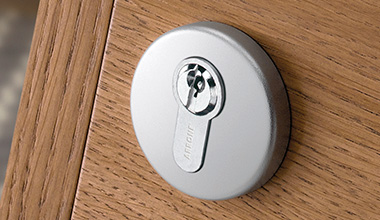HOPPE News
Getting a handle on ironmongery for fire doors
Building owners and managers of residential tower blocks and houses in multiple occupancy (HMO) have a responsibility to their tenants to make sure that the fire doors in their building, and the hardware used to operate it, are compliant.
Fire doors are designed to compartmentalise a building to help save lives and protect property in the event of a fire. To do this a fire door must be installed correctly so that it fully closes into its frame, helping to restrict the spread of fire and toxic smoke for a set period of time. Architectural ironmongery plays a crucial role in ensuring this happens.
The HOPPE (UK) technical team has highlighted some of the key considerations that must be made when specifying, replacing or maintaining fire door hardware in HMOs and tower blocks.
1. Install correct, compliant hardware
The diagrams below show the key components of a fire door on an escape route, and the standards they must be tested to in order to be used on a fire door:


If any component needs replacing, the new product must have been tested as a combination by the door manufacturer and the fire/mechanical performance must be equal to or better than that of the door.
2. Check that all products have been fire tested
It is mandatory to CE mark life safety products (hinges, door closing devices, locks, panic and emergency exit hardware and door coordinators) on fire and escape doors. Any product that is CE marked must also by law have a Declaration of Performance (DoP) in accordance with the Construction Products Regulation 2011.
A CE mark may not always be visible, but it must be on the product, instructions, or packaging. HOPPE (UK) also uses Certifire, an independent third-party accreditation scheme, for its CE marked products.

3. Fit hardware in line with manufacturer’s instructions
Hardware must be tested by the door manufacturer on the specific type of fire door that it is being installed on. The door manufacturer’s test evidence will outline which hardware has been tested with, and is therefore applicable to, the fire door being specified.
Hinges, door closing devices, and locks and latches are critical to a fire door’s performance. In the event of a fire, these products combine to close and secure the door in its frame, allowing intumescent protection contained within the door, frame and around the hardware to expand and fill any gaps.
Hardware must be fitted in accordance with the manufacturer’s fitting instructions. Incorrect fitting of these products will affect the integrity and performance of the fire door.
4. Know your responsibilities
A fire door needs regular maintenance and checks to prevent and address issues that could impact performance. Under the Regulatory Reform (Fire Safety) Order 2005, a suitable and sufficient fire risk assessment carried out by, or on behalf of, the responsible person. The exact frequency of these assessments is not currently specified, but the Local Government Association advises the following: for a low risk, modern, low-rise block, a review every two years might be sufficient, with a new fire risk assessment completed every four years. For blocks with higher risk and blocks over four storeys in height, an annual review might be more appropriate, with a new fire risk assessment every three years. In very high-risk situations, an annual fire risk assessment might be required.
When inspecting the ironmongery on a fire door, here are some key things to check:
- CE marked hinges should be firmly fixed with no missing screws
- Seals are fitted at the top and sides of the door
- The door closer shuts the door firmly into the latch from any position
If in doubt about any fire door hardware, consult with the original door manufacturer or contact one of HOPPE (UK)’s Guild of Architectural Ironmongers (GAI) qualified experts for advice on 01902 484 400.




